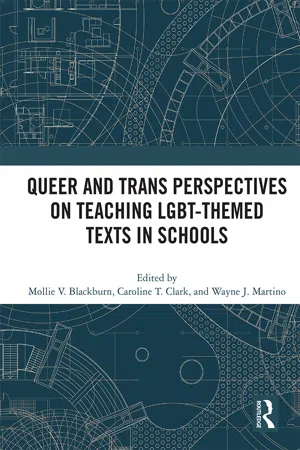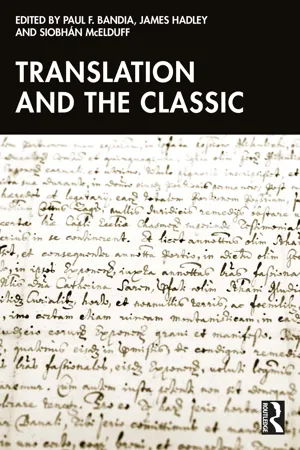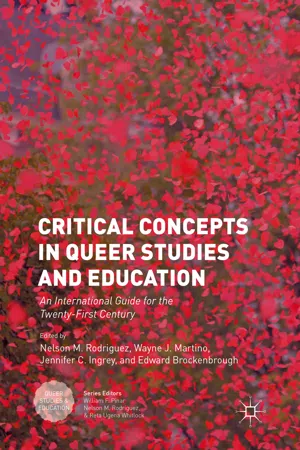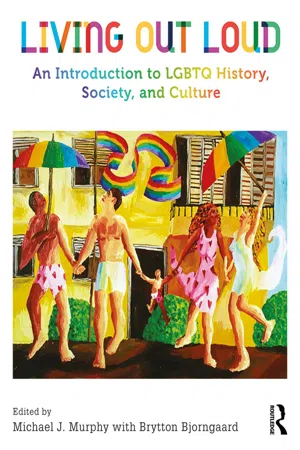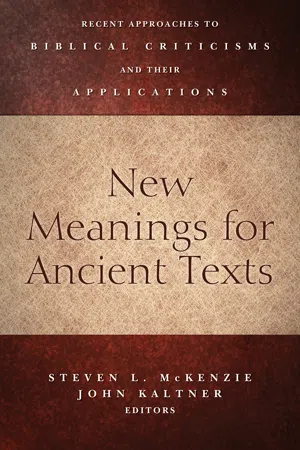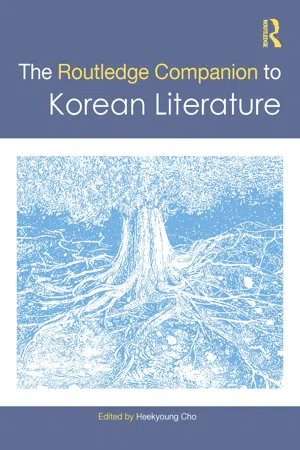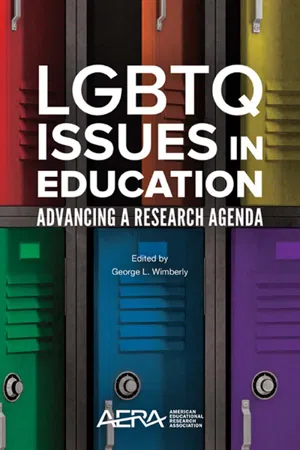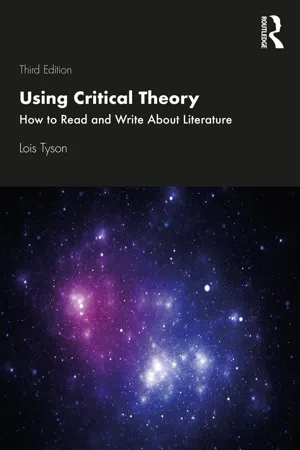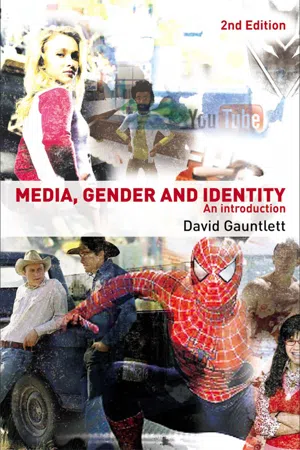Literature
Queer Literature
Queer literature encompasses works that explore LGBTQ+ themes, characters, and experiences. It often challenges traditional norms of gender and sexuality, offering diverse perspectives and narratives. This genre of literature provides a platform for marginalized voices and contributes to a more inclusive literary landscape.
Written by Perlego with AI-assistance
Related key terms
12 Key excerpts on "Queer Literature"
- Mollie V. Blackburn, Caroline T. Clark, Wayne J. Martino, Mollie V. Blackburn, Caroline T. Clark, Wayne J. Martino(Authors)
- 2018(Publication Date)
- Routledge(Publisher)
Speak) have shaped the protagonist in these novels as outsiders, without adult support, whose peers try hard to ‘normalize’ them into their societies. Books with LGBTQ characters often fall into this ‘normalized’ role in YA literature, and many of these books possess the hopeful endings that characterize much in this genre and could be seen to continue, challenge, and contribute to that tradition of the ‘outsider’.- Categorizing YA literature featuring LGBTQ and gender variant themes and characters
There were four overall approaches which instructors took to include LGBTQ-themed literature into their courses. First, YA literature featuring LGBTQ and gender variant themes and characters were included in the syllabus in a list with all of the other novels to be read for the course, without any identifying characteristic such as plot, content, or genre other than that they reflected the course’s objectives. Examining the weekly assignments from these syllabi indicated that students were to read, quiz, discuss, and respond, usually in writing, to the books (and presumably the instructor would lecture). In the second approach, novels were classified into genres and read as an exemplar of that genre. Novels with LGBTQ and gender variant themes and characters were usually included in the genres of realistic fiction, romance novels, or multicultural literature. In the third approach, these texts were thematically characterized into categories such as ‘Bullies and Buddies’, ‘Challenges of Prejudice’, and the ‘Celluloid Closet’. In the fourth approach, these novels were grouped into according to content: LGBT, sexuality, identity, and homosexuality in YA literature. Several syllabi, no matter their approach, often included additional reading lists for students. For example, there might be a list of 20 books and students were to read 5 of those books. Or students were given a list of contemporary topics related to adolescence and asked to find a book that dealt with one of those topics.- eBook - ePub
- Paul F. Bandia, James Hadley, Siobhán McElduff(Authors)
- 2024(Publication Date)
- Routledge(Publisher)
Epstein and Gillett, 2017 ).In the case studies that I explore below, I have chosen English-language texts that were written by authors who were more or less openly queer in their sexual practices,1 while the texts themselves are in some way about queer lives and/or have queer tones or employ queer language. Each of the examples meets more than one of these criteria. I was also limited by the need to choose books that have been translated into a language I can read. They are all modern works, from the 20th century, which reveals how difficult it may have been for an LGBTQ+ author in earlier times to write, regardless of how openly versus subtly, in a way that touched queerness to at least some extent and to see such a text get published and even translated.5.1.5 The Translation of Queer Classics
What is particularly relevant for this chapter is to consider which texts get translated, by whom, to which languages, and in which situations. When looking at the concept of the canon above, I explored how canon formation is based on power and capital; the same extends to choices around translation (see Mukherjee, 2014 : 9). While certain authors have traditionally been translated and even re-translated across time from or to English, others have been neglected, and our increasing awareness of the importance of multiculturalism, diversity, intersectionality, and related concepts has encouraged some of the challenges mentioned before the traditional canon. McCallum asks, ‘What would the traditional introductory English Literature course, usually entitled “English Literature from Chaucer to the Present,” be like if it contained the work of women writers’ (1989: 131)? Here, we can add to her question: what would such a course look like if it contained more translated (non-English-language) writers and more queer writers? Given the ongoing efforts of groups such as Women in Translation (https://womenintranslation.com/ - 5 DIVERSE EROTICISMS
QUEER (NON)IDENTITIES
The emergence of queer theory in the 1990s served at least two main purposes in academic inquiries into sexuality. On the one hand, the rebellious employment of the once-stigmatized term ‘queer’ has questioned, if not undermined, the essentialist assumptions about identity politics that activist groups are supposed to have made about the seemingly stable and exclusive meanings of the words ‘lesbian’ and ‘gay’. In campaigns aimed at fighting discrimination and inspiring lesbian and gay pride, political groupings had since the mid-twentieth century based their goals on protecting the lives, needs and rights of recognizable sexual constituencies that had frequently suffered many different forms of disapproval, prohibition and violence in both private and public spaces. Both ‘lesbian’ and ‘gay’ remain highly prominent terms that define individuals and communities demanding freedom for the right to live, associate and enjoy intimacy with members of their own sex. While ‘queer’ has in many ways continued these political objectives by extending the activism of organizations such as Queer Nation, the term at the same time has demanded much greater inclusivity and respect for a broad range of oppositional forms of sexual expression that were not originally recognizable through the words ‘lesbian’ and ‘gay’. On the other hand, in its impulse to respect the diversity of sexual modalities of being, the advent of queer theory has encouraged researchers to look more attentively at the growing body of writings that address insubordinate and frequently stigmatized sexual subjectivities that do not readily fall strictly within identities founded on same-sex desire. Accordingly, spokespeople within bisexual, transgender and transsexual communities, in particular, have demanded recognition of the specific claims that characterize their sexualities, often in ways that expose the limitations of viewing sexuality by way of reference to terms that posit an authentic, fixed or uniform identity. - eBook - ePub
Critical Concepts in Queer Studies and Education
An International Guide for the Twenty-First Century
- Nelson M. Rodriguez, Wayne J. Martino, Jennifer C. Ingrey, Edward Brockenbrough, Nelson M. Rodriguez, Wayne J. Martino, Jennifer C. Ingrey, Edward Brockenbrough(Authors)
- 2016(Publication Date)
- Palgrave Macmillan(Publisher)
© The Author(s) 2016Begin AbstractCritical Concepts in Queer Studies and Education Queer Studies and Education 10.1057/978-1-137-55425-3_26Nelson M. Rodriguez ,Wayne J. Martino ,Jennifer C. Ingrey andEdward Brockenbrough (eds.)Queer Literacy Framework
End Abstractsj Miller 1(1) New York University, Metropolitan Center for Research on Equity and the Transformation of Schools, New York, NY, USAHistoriography: Building the Queer Literacy Framework
Gender and sexuality norms, conscribed under heteropatriarchy—a history we never made—have colonized and established violent and unstable social and educational climates for the millennial generation of lesbian, gay, bisexual, trans*, intersex, agender/asexual, gender creative, and questioning youth (LGBT*IAGCQM ) (Miller 2014c ). While many studies by the Gay, Lesbian, and Straight Education Network (GLSEN) and their allies show that LGBT*IAGCQM students feel safer overall in schools than their LGBT*IAGCQ predecessors, due to shifts in national and state policies and amendments advocating for LGBT rights, state antibullying laws, increased numbers of Gay–Straight Alliances, and a wider social acceptance of LGBT*IAGCQ people, schools still struggle to normalize the inclusion of an LGBT*IAGCQ-positive curricula (GLSEN 2011 , 2013 ; Kosciw et al. 2010 ). This work addresses, through a queer literacy framework (QLF), how teacher educators can support preservice teachers to understand and read (a)gender and (a)sexuality1 - eBook - ePub
Living Out Loud
An Introduction to LGBTQ History, Society, and Culture
- Michael Murphy, Brytton Bjorngaard, Michael J. Murphy, Brytton Bjorngaard(Authors)
- 2018(Publication Date)
- Routledge(Publisher)
Authors such as Emily Dickinson, Tennessee Williams, and Alice Walker (to name only a few) lived lives or wrote about characters with complex sexual attractions, behaviors, and desires having expansive and fluid gender identities and expressions. These authors are frequently studied in high-school English classrooms, opening a prime opportunity for students to consider the significant contributions of LGBTQ + authors and texts to academic literary culture (Greenbaum, 1994). Providing students with opportunities to consider themes, subtexts, and language that speaks to same-sex attraction or to gender-expansive perspectives may expand students’ understanding of literary aesthetics beyond the politics of identity and representation. Family dynamics, love, belonging, power, and the complexities of the natural world are all examples of literary topics discussed in the English classroom that, when viewed through an LGBTQ + lens, can open the door for literary interpretations that reject normative perspectives and create classroom climates embracing a range of voices. Additionally, examinations of how masculine and feminine are portrayed in literary characters and by authors offers students opportunities to disrupt gender expectations and see the spectrum of gender performances represented in literature. Finally, teachers and students can learn to engage in “queer readings” of texts (Shlasko, 2005, p.130). This approach requires readers not only to identify and name LGBTQ + or gender expansive elements presented in a text, but also to interpret texts based on alternative understandings. For example, instead of asking, “What’s the text say and mean?” students might ask, “What else could this text mean?” and “What did I want to find or avoid finding in the text?” (Kumashiro, 2002). These questions push students to shift assumptions about gender and sexual orientation - eBook - ePub
New Meanings for Ancient Texts
Recent Approaches to Biblical Criticisms and Their Applications
- Steven L. McKenzie, John Kaltner(Authors)
- 2013(Publication Date)
- Westminster John Knox Press(Publisher)
2 It would not be quite right to call the resulting queer criticism a method, if by method one means a set of agreed upon steps that reliably lead disciplined readers to shared conclusions. However, queer criticism can be understood as a kind of interpretive sensibility or style of reading, which shapes particular interpretations of texts to varying degrees.Although it will be important to keep in mind the heterogeneity of queer commentary that Berlant and Warner emphasize, in this chapter the most significant characteristics of queer criticism include the following:- Queer criticism calls attention to sexual practice and gender, often in relation to one another, as key sites for the interpretation of cultural, social, and textual meanings and practices.
- Queer criticism emphasizes the fact that meanings and practices associated with sex, gender, and kinship vary significantly across cultures and histories, or even within a single culture. This emphasis contrasts with all attempts to stabilize the meanings and practices associated with sex, gender, or kinship by grounding them in a supposedly unchanging nature, assumed cultural universals, or religious revelation.
- Working under the influence of thinkers and ideas associated with “queer theory,” queer criticism tends to be suspicious of organizing sexual and gender meanings too rigidly around stable binary oppositions such as male and female, masculine and feminine, or heterosexual and homosexual. Instead, queer criticism emphasizes the fluidity and unpredictability of gender, sexual desire, and sexual practice, as well as the instability of the binary oppositions that are thought to structure them.
- The tendency for readers (including scholars) to universalize a particular set of modern, Western norms for sexual practice, gender roles, and family structures is analyzed critically by queer criticism as “heteronormative.” At its most basic, “heteronormativity” is the institutionalized preference for opposite-sex sexual relationships over same-sex sexual relationships. However, a number of other assumptions and practices are also associated with heteronormativity, including the beliefs that binary gender roles follow naturally from biological sex; that sexual desire and sexual practice follow from gender roles and/or biological sex; that an individual’s biological sex, gender roles, sexual desires, or sexual practices are consistent over time; that kinship units ideally form around a monogamous, opposite-sex couple; and that sexual activity is most appropriately aimed at romantic love, reproduction, and childbirth. Although heteronormativity may appear to be self-evidently good to its supporters, queer criticism notes that heteronormativity often leads to the marginalization or persecution of individuals and populations who fall short of its ideals.
- eBook - ePub
- Heekyoung Cho, Heekyoung Cho(Authors)
- 2022(Publication Date)
- Routledge(Publisher)
Despite the increasing interest in Queer Literature in the literary field, there is still an imbalance of critical and scholarly attention in terms of genre diversity, as more scholarly or critical attention has been given to prose than to other literary forms. In fact, analyses of prose, especially novels and short stories, overwhelmingly outweigh those of other genres in number. In particular, there is a notable dearth of criticism that highlights queerness in poetry, except for a few scholarly endeavors analyzing collections of poems with explicitly queer subjects, such as Hwang Pyŏngsŭng’s Shik’ok’u, the Cross-dresser and Kim Hyŏn’s Glory Hole (Kŭllori hol). Even considering the relative popularity of prose in the reading population, the near absence of criticism of queer poetry is surprising. The relative dearth of studies on queer poetry at least partially reflects the tendency in criticism to find the interpretative clue of queerness in either the author’s personal stake or the obvious representation of non-normative sexuality, as poetry often “detours” the narrative by using figurative language and imagery. The only comprehensive study overviewing queer Korean poetry thus far is an article by Chŏng Kkŭtpyŏl. Chŏng also heavily relies on the significance of authorial agency in appreciating queer poetry. She argues that “the politics of queer is guaranteed through Tangsajasŏng and the representational strategy” (Chŏng 2020, 42). While depreciating queer poetry by Hwang Pyŏngsŭng as a literary representation of an “androcentric sexuality based on bi-gender dichotomy” (Chŏng 2020, 40), Chŏng praises poems by Kim Hyŏn as a poetic example of “the power of speech originated from one’s self-identification and self-description as well as the politics of the very power” (Chŏng 2020, 43) - eBook - ePub
- George Wimberly(Author)
- 2015(Publication Date)
- American Educational Research Association(Publisher)
These discriminatory effects on schooling are found even when the political or policy fight over sexuality is not overtly connected to schools or those who work or learn within them. This occurs in three ways. First, purity campaigns and moral panics over the corruption of school-aged children have been endemic to efforts to regulate sexuality and constrain LGBTQ rights in areas such as sexual relations, marriage, and the military (Herdt, 2009). Second, stigmatization and criminalization of queer identity have led to concrete forms of discrimination in the everyday (school) lives of LGBTQ educators, parents, and students and their allies. Third, a combination of this regulation and discrimination has led to institutionalized forms of invisibility, rendering absent LGBTQ people who exist within the school community. Recent sociolegal changes have begun to address these concerns; we highlight them throughout this chapter.A note on terminology: We use the term queer throughout to mean individuals who have been perceived by society or have considered themselves to be lesbian, gay, bisexual, transgender, transsexual, intersexual, queer and/or questioning. We acknowledge that this term is a “recovered slur” and that, as such, its use is troublesome. We also use queer as normative—with nonqueers, who are more commonly known as heterosexuals and/or gender-conforming persons, considered to be somewhat lacking. While perhaps jarring for the uninitiated, both “queer” and “nonqueer” are linguistically consistent with the theoretical lens that we employ for this chapter—the lens of Queer Legal Theory (QLT) (Hutchinson, 1997, 1999; Valdes, 1995, 1997, 2004). Below we analyze the politics of public policy related to such regulated, criminalized, and stigmatized identities while also identifying the conditions that sustain or challenge the bias against LGBTQ people and issues in U.S. schools. We draw on QLT as an overarching framework in which these trends may be understood and through which future research may be imagined.A Brief Discussion of Queer Legal TheoryQueer Legal Theory1 - eBook - ePub
Using Critical Theory
How to Read and Write About Literature
- Lois Tyson(Author)
- 2020(Publication Date)
- Routledge(Publisher)
If you’ve worked through all of the interpretation exercises offered in this chapter, you should feel quite familiar with the basic approaches to understanding literature provided by concepts from lesbian, gay, and queer theories. Specifically, we’ve seen how concepts from lesbian, gay, and queer theories can be used to analyze1 literary works that provide positive images of LGBTQ people (our example: “Don’t Explain”), 2 literary works that illustrate the operations of homophobia (our example: “The Battle Royal”), 3 literary works with a lesbian, gay, or queer subtext that contributes a subtle but important element to the lives of heterosexual characters (our example: “Everyday Use”),4 literary works that illustrate the first principle of queer theory: that the opposition of the categories heterosexual and homosexual is inadequate for understanding the complexities of human sexuality (our example: “A Rose for Emily”), and5 literary works whose lesbian, gay, or queer dimension can be understood best when analyzed in the context of other works by the author, perhaps with some support from biographical materials (our example: “I started Early—Took my Dog”).For many students new to the concepts provided by lesbian, gay, and queer theories, the interpretation exercises in this chapter might seem vague or flimsy or even confusing. Keep in mind that any initial difficulty we might have in using these concepts will be due largely to the fact that we’ve been trained by heterosexist society not to be able to see the lesbian, gay, or queer dimension of literary works, despite the large number of LGBTQ authors in the canon of Western literature. And we’ve been fed so many myths about LGBTQ people for so long that we think our heterosexist biases—in our literary analyses as in other areas of our lives—are not biases but reasonable responses to accurate information.Probably the most destructive myth about LGBTQ people, which heterosexist culture promotes in order to justify its anti-LGBTQ sentiments, is the myth that LGBTQ individuals are sick or evil. However, if some sexualities are sick or evil, surely they are those involving such behaviors as rape, the sexual abuse of children, or any other form of cruelty inflicted on an unwilling partner. Such behaviors aren’t related to whether an individual is straight, lesbian, gay, bisexual, transgender, or queer. These behaviors appear in individuals regardless of their sexual orientation. Remember, then, that our sexual orientation indicates only one thing about us: it indicates whether we’re romantically drawn to people of the opposite sex, people of the same sex, or people of both sexes. Our opposite-sex or same-sex orientation is not an indication of our capacity for kindness, generosity, sensitivity, honesty, or any other quality that we generally use to define human goodness or health. Nevertheless, arguments that LGBTQ people are sick or evil still abound, so I think you might find it helpful to be acquainted both with some of the assumptions on which these arguments are based and with some of the counterarguments generally offered in response. Let me summarize them for you now. - eBook - ePub
Radical Love
An Introduction to Queer Theology
- Patrick S. Cheng(Author)
- 2011(Publication Date)
- Seabury Books(Publisher)
Thus, the third meaning of “queer” is the erasing or deconstructing of boundaries, particularly with respect to the essentialist or fixed binary categories of sexuality and gender. As we have seen, this meaning of “queer” is grounded in the academic fields of queer studies and queer theory, which in turn is based upon the work of academics such as Michel Foucault, Judith Butler, and Eve Kosofsky Sedgwick.Defining Queer Theology
So what exactly is queer theology? If theology is “talk about God,” then, in light of the above three definitions of “queer,” there are at least three possible definitions for “queer theology.” First, queer theology is LGBT people “talking about God.” Second, queer theology is “talking about God” in a selfconsciously transgressive manner, especially in terms of challenging societal norms about sexuality and gender. Third, queer theology is “talk about God” that challenges and deconstructs the natural binary categories of sexual and gender identity. Let us examine each of these three definitions in turn.First, in light of the umbrella or collective term definition of “queer,” queer theology can be understood as LGBT people “talking about God.” In other words, queer theology is a shorthand term for theology that is done by and for LGBT people. Thus, instead of writing the phrase “talk about God by and for lesbian, gay, bisexual, transgender, intersex, questioning people as well as our allies” over and over again, we can simply use the term “queer theology” as shorthand. As we have seen, Nancy Wilson has articulated what she calls a “queer theology of sexuality” that is grounded in bodily hospitality. For Wilson, this queer theology speaks to gay men, lesbians, bisexual people, and others who identify as “queer.”14Second, in light of the definition of “queer” as transgression, queer theology can be understood as a theological method that is self-consciously transgressive, especially by challenging societal norms about sexuality and gender. Thus, queer theology refers to a way of doing theology that, in the words of the Magnificat, brings down the powerful and lifts up the lowly.15 In particular, this theology seeks to unearth silenced voices or hidden perspectives. One example of this kind of theology is the “indecent theology” of the late bisexual theologian Marcella Althaus-Reid from the University of Edinburgh. According to Althaus-Reid, queer theology should shock people out of their complacency and help them see theology in a new light. Althaus-Reid certainly did that in her books Indecent Theology and The Queer God, which contained provocative chapters such as “Oral Sex: sexual his/torias in oral theology”16 and “Kneeling: deviant theologians.”17 - eBook - ePub
Your Place or Mine?
A 21st Century Essay on Same Sex
- Gilles Dauvé(Author)
- 2022(Publication Date)
- PM Press(Publisher)
Queer is not merely another identity that can be tacked onto a list of neat social categories, nor the quantitative sum of our identities. Rather, it is the qualitative position of opposition to presentations of stability— an identity that problematizes the manageable limits of identity. Queer is a territory of tension, defined against the dominant narrative of white-hetero-monogamous-patriarchy, but also by an affinity with all who are marginalized, otherized and oppressed. Queer is the abnormal, the strange, the dangerous. Queer involves our sexuality and our gender, but so much more. It is our desire and fantasies and more still.… Queer is the cohesion of everything in conflict with the heterosexual capitalist world.… By “queer,” we mean “social war.”To recap, “queer” bridges all gaps. A 2009 leaflet spoke of all the dominated and oppressed, “trans, women, POC [persons or people of color],” which means millions, billions, certainly not defined by class, however:When we speak of social war, we do so because purist class analysis is not enough for us. What does a Marxist economic worldview mean to a survivor of bashing? To a sex worker? To a homeless, teenage runaway? How can class analysis, alone as paradigm for a revolution, promise liberation to those of us journeying beyond our assigned genders and sexualities? The Proletariat as revolutionary subject marginalizes all whose lives don’t fit in the model of heterosexual-worker.Really? It is doubtful that a gay bourgeois and a gay prole equally risk and suffer bashing, so class analysis is not as irrelevant as it might seem.More importantly, if “social war” is not determined by “economic” working conditions, what causes it? We are told that “queer” is what stands in out-and-out opposition to the existing world, so society is to be criticized “from the point of view of queer experience,” which joins the experience of all marginalized and oppressed people. Radical queer politics starts from what sexual minorities can have in common with people of color, transgender persons, migrants, sex workers, the poor, and the most deprived. In other words, categories of people who are not only the most oppressed but also do not oppress others: for instance, this excludes workers who engage in sexist or racist behavior and those middle-class gays and lesbians who despise transgenderism. So, not simply the “wretched of the Earth,” but the most - eBook - ePub
Media, Gender and Identity
An Introduction
- David Gauntlett(Author)
- 2008(Publication Date)
- Routledge(Publisher)
Gender Trouble by Judith Butler. (Also important, within the version of queer theory which is concerned with literature rather than social identities, is the work of Eve Kosofsky Sedgwick, which challenges assumptions about sexuality in literature.)Figure 7.1 Judith ButlerIt is also worth mentioning that Butler is unlikely to win any awards for clarity of writing style. (On the contrary, indeed, she once won an annual international award for having produced the most incomprehensible academic text.) Her prose is unnecessarily dense and long-winded, and almost never fails to use jargon even where much more accessible vocabulary is available. Some people defend this, saying that academics should be allowed to develop complex terminology to express their sophisticated ideas – after all, nobody expects to read journals about rocket science and understand all of it straight away. However, although Butler’s writing is like an explosion in a dictionary factory, if one takes time to dig through the rubble one finds that her ideas are actually quite straightforward. So let’s get started.QUEER THEORY SUMMARY
We’ll need to look at each of these points in more detail to fully understand their meaning and implications, but here’s the simple summary of what queer theory is about:- Nothing within your identity is fixed.
- Your identity is little more than a pile of (social and cultural) things which you have previously expressed, or which have been said about you.
- There is not really an ‘inner self’. We come to believe we have one through the repetition of discourses about it.
- Gender, like other aspects of identity, is a performance (though not necessarily a consciously chosen one). Again, this is reinforced through repetition.
Index pages curate the most relevant extracts from our library of academic textbooks. They’ve been created using an in-house natural language model (NLM), each adding context and meaning to key research topics.
